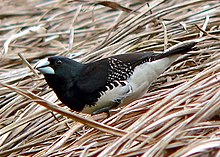Glossy magpie
| Glossy magpie | ||||||||||||
|---|---|---|---|---|---|---|---|---|---|---|---|---|

Glossy magpie ( Lonchura bicolor ) |
||||||||||||
| Systematics | ||||||||||||
|
||||||||||||
| Scientific name | ||||||||||||
| Lonchura bicolor | ||||||||||||
| ( Fraser , 1843) |

The glossy elster ( Lonchura bicolor ), also called brown-backed elster , black-headed elster , red-backed elster , latticed winged elster (subspecies Lonchura bicolor poensis ) or katanga elster , is one of the African bird species of the finch family . Together with the little elster and the giant elster , it was previously classified in the genus of the elster . Today it is counted together with these species as a bronze male.
There are several subspecies, which differ in the color of the back and wings.
description
Glossy pearls reach a body length of nine to ten centimeters and weigh an average of just under ten grams. They belong to the finch species that tend to stay small. The species has no sexual dimorphism .
The head and neck of the glossy elster are glossy black. In the nominate form Lonchura bicolor bicolor and the subspecies L. b. poensis , the back, the wing covers and the innermost wings are black. The other subspecies are colored brown in these parts of the body. The other wings are black and, except for the nominate shape, are dotted with white dots so that a grid-like pattern is created. The rump and upper tail-coverts are black. The underside of the body is white, while the sides of the body are black with white feather edges. The strong beak is light to lead gray, the eyes are brown.
Young birds are dark brown on the upper side of the body, the hand wings are black. They resemble the young birds of the dwarf star and also have the same throat markings, but are a little more contrasting in color.
Distribution area and way of life
The glossy elster occurs from Gambia and Guinea in western Africa via Cameroon to Kenya and on the east coast of the African continent to South Africa . The habitat are clearings and forest edges, tall grass and bushes on stream banks and the edge of swamps as well as overgrown plantings. In the east of the distribution area, the glossy elster is also found in gallery forests and the thickets on river banks of the savannah. The altitude distribution extends to altitudes of 2000 meters above sea level.
Like many other fine finch species, the glossy elster is a gregarious species that can be observed outside of the breeding season in groups of usually thirty to forty individuals. They often sit close together on branches or wires. The food consists mainly of grass seeds, but they also eat insects. In some regions, the pulp of the oil palm also plays a role in their diet. As with some other species of bronze male, the glossy elster has been observed to eat algae.
The breeding season falls in the rainy season and varies accordingly depending on the distribution area. They breed in Uganda from April to August, in Sierra Leone from September to December. Glitzelsterchen are free breeders. Their nest is usually two to seven meters above the ground and is usually well hidden in leafy trees or bushes. Bamboo and creepers are also used as nesting sites. They use blades of grass and coconut fibers as nesting material. The female lays between three and six white-shell eggs. They are incubated for 11 to 13 days.
attitude
The shiny elster was first introduced to Europe in 1888. It was the subspecies Lonchura bicolor poensis , the so-called lattice winged lilac, with which there are numerous white pits on the wings, so that a white lattice pattern is created. In 1895, the subspecies Lonchura bicolor nigriceps was introduced, which is known in German as brown-backed elster because of its maroon wings and maroon back.
supporting documents
literature
- Horst Bielfeld : Knowing and caring for 300 ornamental birds. Ulmer Verlag, Stuttgart 2009, ISBN 978-3-8001-5737-2 .
- Jürgen Nicolai (Ed.), Joachim Steinbacher (Ed.), Renate van den Elzen, Gerhard Hofmann: Prachtfinken - Australia, Oceania, Southeast Asia. Eugen Ulmer Verlag, Stuttgart 2001, ISBN 3-8001-3249-4 .
- Peter Clement , Alan Harris, John Davis: Finches and Sparrows. An Identification Guide. Christopher Helm, London 1993, ISBN 0-7136-8017-2 .
Web links
- BirdLife factsheet
- Lonchura bicolor inthe IUCN 2013 Red List of Threatened Species . Listed by: BirdLife International, 2012. Retrieved October 9, 2013.
